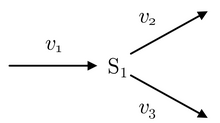Branched pathways, also known as branch points (not to be confused with the mathematical branch point), are a common pattern found in metabolism. This is where an intermediate species is chemically made or transformed by multiple enzymatic processes. linear pathways only have one enzymatic reaction producing a species and one enzymatic reaction consuming the species.
Branched pathways are present in numerous metabolic reactions, including glycolysis, the synthesis of lysine, glutamine, and penicillin,[1] and in the production of the aromatic amino acids.[2]

In general, a single branch may have producing branches and consuming branches. If the intermediate at the branch point is given by , then the rate of change of is given by:
At steady-state when the consumption and production rates must be equal:
Biochemical pathways can be investigated by computer simulation or by looking at the sensitivities, i.e. control coefficients for flux and species concentrations using metabolic control analysis.
- ^ Heijnen, J. J.; van Gulik, W. M.; Shimizu, H.; Stephanopoulos, G. (2004-10-01). "Metabolic flux control analysis of branch points: an improved approach to obtain flux control coefficients from large perturbation data". Metabolic Engineering. 6 (4): 391–400. doi:10.1016/j.ymben.2004.07.002. ISSN 1096-7176. PMID 15491867.
- ^ "W_2022_Bis2a_Igo_Reading_15". Biology LibreTexts. 2021-12-13. Retrieved 2022-12-15.







